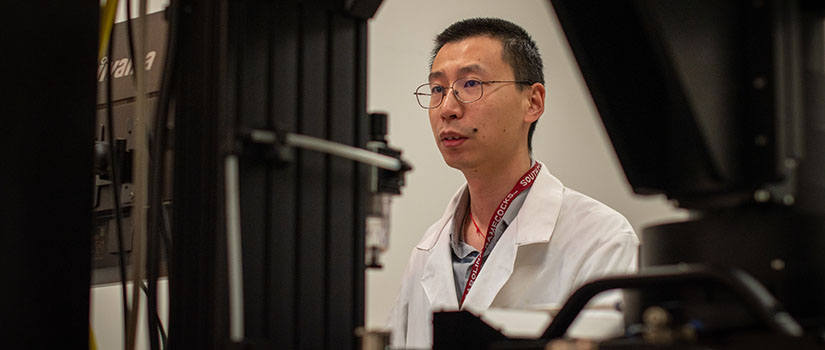Additive Manufacturing, which is essentially 3D printing, is the process of creating an object by building one layer at a time. Its proven advantages include the ability to consolidate assemblies into a single part and enable highly complex designs with customized structural and functional properties. But different processes and environmental conditions can lead to inconsistencies and defects in part quality.
Mechanical Engineering Associate Professor Lang Yuan’s research focuses on microstructure and defect formation in metal-based additive manufacturing. He recently began a two-year, nearly $1 million project that aims to characterize microstructure and defects utilizing ultrasound-based methods in laser powder bed fusion (LBPF) additive manufacturing.
“Part of the challenges for the metal 3D printing process are the existence of defects and not knowing the characteristics type of microstructure produced unless it’s examined through expensive and time-consuming material characterizations,” Yuan says. “Our project intends to gather and analyze data, hear ultrasound signals in real time and identify the defects during the printing process.”
The project, “Real-time in situ microstructure characterization by ultrasound in additive manufacturing,” is sponsored by the National Institute of Standards and Technology and the Department of Commerce. Yuan’s team includes co-principal investigator Austin Downey of the Department of Mechanical Engineering and researchers from Purdue University and the University of Illinois Urbana-Champaign (UIUC).
While still in its infancy, ultrasound-based methods for in situ (original place) process monitoring in metals-based additive manufacturing is performed by layering and vibrating thin metal sheets when they are fused together. The planned new hardware and software platform is intended to characterize the microstructure and defects of parts in real-time using ultrasound non-destructive evaluation (NDE) in the LPBF additive manufacturing process. An-image based in situ monitoring system has been actively developed for process manufacturing understanding and control.
“With our process, we want to explore how defects and microstructures react to linear and nonlinear ultrasound responses and make real time evaluation of the printing quality,” Yuan says. “This development can be complimentary to other technologies and allow us to respond by augmenting the printing parameters or even stopping the print for desired quality.”
The project will be divided into four parts. First, Downey will lead the integration of an ultrasound NDE system with an LPBF additive manufacturing machine to enable acquiring ultrasound responses for real-time data analysis. Ultrasound NDE uses high frequency sound energy to conduct examinations and make measurements. The build platform will be customized, and the ultrasound signal will be collected after each printed layer.
Secondly, a comprehensive ultrasound-microstructure knowledge base via machine learning will be developed for connecting the ultrasound responses to microstructures and defects. The work will include LPBF samples with controlled microstructure and analyzing linear and nonlinear ultrasound signal signatures.
“The microstructure plays an important role in the mechanical properties, which includes texture and grain size. Extensive ex situ (off-site) ultrasound measures will be performed by UIUC to quantity the defects and texture before translating it to the in situ side, driven by machine learning and algorithms,” Yuan says.
To assist the experimental investigation, physics-based computational models for solidification microstructures and ultrasound propagation will be utilized to establish a theoretical baseline and fundamental understanding of ultrasound responses. Finally, based on the online ultrasound signal, a package for managing and deploying a machine learning tool and real-time in situ microstructure and characterizing defects will be implemented.
“Microstructure defects exist in additive manufactured components, resulting in machine-to-machine and vendor-to-vendor variations,” says Xiaoyuan Lou, associate professor of nuclear engineering at Purdue University. “This research creates a pathway to potentially track these unwanted phenomena on the fly when a component is being printed. I believe in-situ ultrasonic characterization offers a greater advantage to resolve the microstructural changes better.”
With the research project in the early stages, Yuan is most excited about the diversified team with unique expertise working together and solving the challenge of the measurement science around ultrasound NSF. The team has taken the initial stride in implementing the hardware, establishing the foundation for subsequent phases of the research, which involve the analysis of signals and real-time data.
